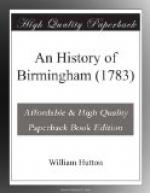Upon the north west extremity of Sutton Coldfield, joining the Chester road, is The Bowen Pool; at the tail of which, one hundred yards west of the road, on a small eminence, or swell of the earth, are the remains of a fortification, called Loaches Banks; but of what use or original is uncertain, no author having mentioned it.
Four hundred yards farther west, in the same flat, is a hill of some magnitude, deemed, by the curious, a tumolus—it is a common thing for an historian to be lost, but not quite so common to acknowledge it. In attempting to visit this tumolus, I soon found myself in the center of a morass; and here, my dear reader might have seen the historian set fast in a double sense. I was obliged, for that evening, February 16, 1783, to retreat, as the sun had just done before me. I made my approaches from another quarter, April 13, when the hill appeared the work of nature, upon too broad a base for a tumolus; covering about three acres, perfectly round, rising gradually to the center, which is about sixteen feet above the level, surrounded by a ditch, perhaps made for some private purpose by the owner.
The Roman tumoli were of two sorts, the small for the reception of a general, or great man, as that at Cloudsley-bush, near the High Cross, the tomb of Claudius; and the large, as at Seckington, near Tamworth, for the reception of the dead, after a battle: they are both of the same shape, rather high than broad. That before us comes under the description of neither; nor could the dead well be conveyed over the morass.
The ground-plot, in the center of the fort, at Loaches Banks, is about two acres, surrounded by three mounds, which are large, and three trenches, which are small; the whole forming a square of four acres. Each corner directs to a cardinal point, but perhaps not with design; for the situation of the ground would invite the operator to chuse the present form. The north-west joins to, and is secured by the pool.
As the works are much in the Roman taste, I might, at first view, deem it the residence of an opulent lord of the manor; but, the adjacent lands carrying no marks of cultivation, destroys the argument; it is also too large for the fashion; besides, all these manorial foundations have been in use since the conquest, therefore tradition assists the historian; but here, tradition being lost, proves the place of greater antiquity.
One might judge it of Danish extraction, but here again, tradition will generally lend her assistance; neither are the trenches large enough for that people: of themselves they are no security, whether full or empty; for an active young fellow might easily skip from one bank to another. Nor can we view it as the work of some whimsical lord, to excite the wonder of the moderns; it could never pay for the trouble. We must, therefore, travel back among the ancient Britons, for a solution, and here we shall travel over solid ground.




